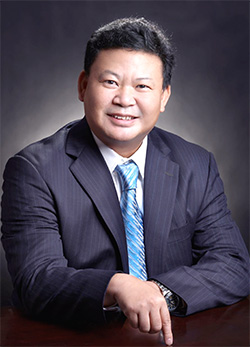MEMS Thermoelectric Chip and Its Applications
Date: 2021/03/10 - 2021/03/10
Academic Seminar: MEMS Thermoelectric Chip and Its Applications
Speaker: Prof. Zhiyu Hu, Zhi Yuan Chair professorship at Shanghai Jiao Tong University
Time: 9:00 a.m.-10:00 a.m., March 10th, 2021 (Beijing Time)
Location: Room 454, Longbin Building (Zoom Meeting ID: 610 8377 5408, Password: 924681)
Abstract
For a long time, mankind has been seeking inexhaustible energy in nature. The high temperature burning of coal, oil, natural gas and other petrochemical energy sources inevitably brings environmental pollution, and the emission of large amounts of greenhouse gases also causes global temperatures to rise. There is an urgent need to obtain new types of sustainable, environmentally friendly and green energy to reduce our dependence on petrochemical energy.
The thermoelectric generator (TEG) can directly convert heat into electrical energy through the Seebeck effect, thereby obtaining electrical energy, which makes it a promising environmentally friendly energy conversion method. TEG has many special advantages, such as no moving parts, no pollution, no noise, no mechanical vibration, etc. At present, all TEGs on the market is made with traditional method which yields high cost, low efficiency, not suitable for massive and economic production.
Taking advantages of micro/nano-fabrication and the scale effects of heat theory, we are able to design and build a thermoelectric chip in a large array and maintain a stable temperature difference between sub-micrometer-thick of a thermoelectric unit on a silicon wafer. Here we present a reliable and efficient hybrid fabrication method for ultrathin thermoelectric devices based on the non-contact exposing, photoresist melting and microfabrication technology. Experimental results indicate that ultrathin thermoelectric device works stable and reliable, and is suitable for fabrication of thinner and higher integrality devices in mass production. We have demonstrated a novel energy utilization that MEMS-based thermoelectric chip can produce electrical power by radiative cooling (RC) around the clock. Nanostructured multilayer thermoelectric films have been developed to improve thermoelectric efficiency. The effects of interface microstructure on the cross-plane thermal conductivities of the multilayer thin films have been extensively examined and the thermal transfer mechanism has been explored. Both experimental and theoretical understanding of the thermal transport properties of TE/metal multilayer thin film junctions with important implications for exploring a novel approach to improving the thermoelectric conversion efficiency.
MEMS-based thermoelectric chips can use ultra-low thermal energy to directly generate electricity with a very small temperature difference. In future, when such advanced energy technology is wildly available and at very low costs, we then will obtain truly sustainable, completely environmentally friendly clean energy, and greatly reducing our dependence on petrochemical energy. MEMS-based thermoelectric chip can also be used as an ultra-sensitive temperature sensor, several testing examples will be introduced and with further discussions.
Biography
 Prof. Dr. Zhiyu Hu (Ph.D. MBA), National Chair Professor, is holding a Zhi Yuan Chair professorship at Shanghai Jiao Tong University and was the director (2014-2018) of National Key Laboratory of Science and Technology on Micro-/Nano-Fabrication. He is also the founder and director of the Institute of NanoMicroEnergy since 2008. Dr. Hu is an adjunct professor appointment at University of Tennessee, Knoxville, Tennessee, USA plus other honorary positions in several universities and institutes. He was a research staff member at Oak Ridge National Laboratory (ORNL) of the U.S. Department of Energy. Dr. Hu is the author of more than 100 publications in peer reviewed journals; two books; several dozen invited talks; ninety plus conference presentations and sixty published and pending patents. He is the recipient of many awards that includes Chinese Society of Micro-Nano Technology Innovation Award, Discover Magazine Award, National and Regional Federal Laboratory Consortium awards and several awards from ORNL including The Inventor of the Year Award and Technology Achievement Award. Dr. Hu’s work generated many press accolades and mentions around the world. He is a member of AAAS, APS, ASME, ECS, MRS, ECS and the National Physics Honor Society Sigma Pi Sigma. He is an executive member of Nano Engineering Council of ASME and a committee member of the Sensor Division of ECS.
Prof. Dr. Zhiyu Hu (Ph.D. MBA), National Chair Professor, is holding a Zhi Yuan Chair professorship at Shanghai Jiao Tong University and was the director (2014-2018) of National Key Laboratory of Science and Technology on Micro-/Nano-Fabrication. He is also the founder and director of the Institute of NanoMicroEnergy since 2008. Dr. Hu is an adjunct professor appointment at University of Tennessee, Knoxville, Tennessee, USA plus other honorary positions in several universities and institutes. He was a research staff member at Oak Ridge National Laboratory (ORNL) of the U.S. Department of Energy. Dr. Hu is the author of more than 100 publications in peer reviewed journals; two books; several dozen invited talks; ninety plus conference presentations and sixty published and pending patents. He is the recipient of many awards that includes Chinese Society of Micro-Nano Technology Innovation Award, Discover Magazine Award, National and Regional Federal Laboratory Consortium awards and several awards from ORNL including The Inventor of the Year Award and Technology Achievement Award. Dr. Hu’s work generated many press accolades and mentions around the world. He is a member of AAAS, APS, ASME, ECS, MRS, ECS and the National Physics Honor Society Sigma Pi Sigma. He is an executive member of Nano Engineering Council of ASME and a committee member of the Sensor Division of ECS.
